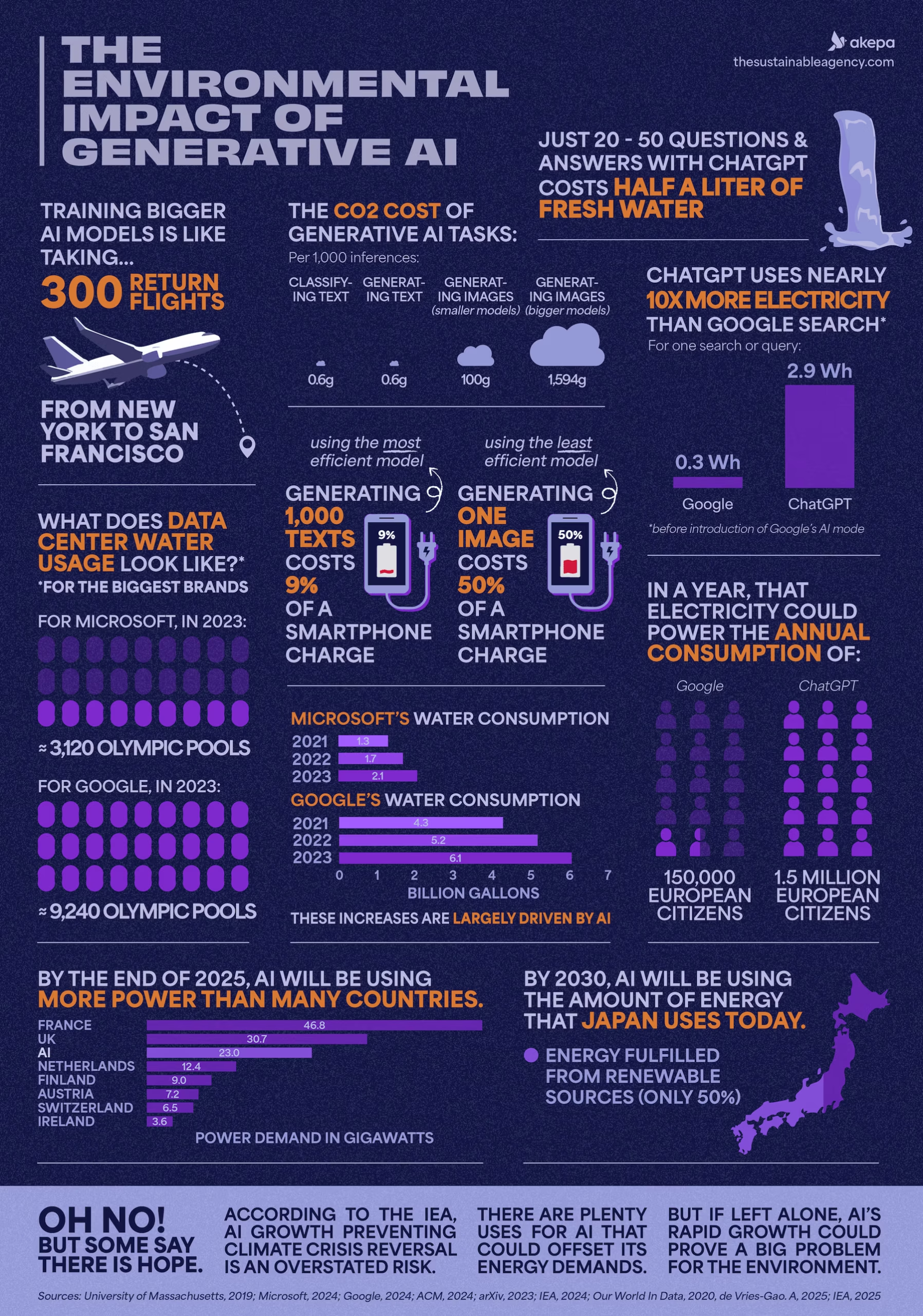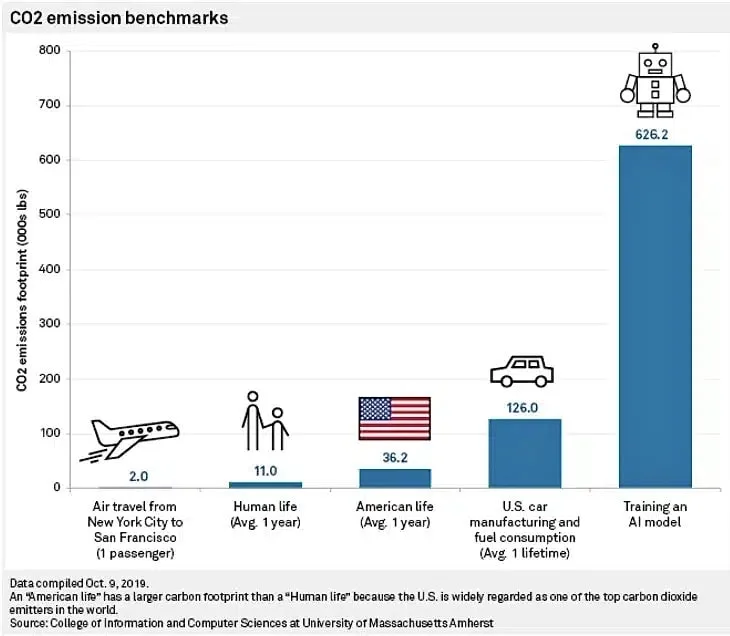Generative AI is a branch of AI that specializes in creating new content such as text, images, videos, or sound. Generative AI creates seemingly original content by being trained on large datasets.
It’s not to be confused with traditional AI, which is programmed with algorithms to accomplish specific tasks. Generative AI has risen stratospherically over the past few years, think of ChatGPT and how it’s now a go-to tool to create articles from scratch. Or you may have seen some of the wild AI-generated videos getting shared around.
As sustainable marketers here at Akepa, we’re keen to move beyond being impressed (or not) and better understand AI’s environmental impact. We’re aware that traditional AI has the potential to positively impact the planet with tools that can predict the weather, identify pollution, improve waste management, and clean up marine plastic. A study by the Boston Consulting Group even stated that if AI is used wisely, it could help mitigate 5 to 10% of GHG emissions by 2030. But generative AI is a different proposition as it requires higher amounts of computational resources and is being used by masses of people at the same time.
So we’ve compiled 20+ statistics on generative AI’s environmental impact and how it could be contributing to the climate crisis – mainly through energy use, carbon emissions, and water use. We’ve also thrown in a few stats about AI’s overall impact, driven by the mass adoption of Gen AI.
Here’s a summary of some of these key stats in infographic form:

And now to the full list of stats, which we’re keeping updated every month:
- In a study of 88 different AI models, it was found that a single AI-generated image can use as much energy as half a smartphone charge, using the least efficient model. Although, there is a large variation between image generational models. (ACM Digital Library, 2024)
- The most carbon-intensive image generation model generates the amount of carbon equivalent to 4.1 miles driven by an average gasoline-powered passenger vehicle for 1,000 inferences (a prediction or response to a query). (ACM Digital Library, 2024)
- But the least carbon-intensive text generation model generates 6,833 times less carbon, equivalent to 0.0006 miles driven by a similar vehicle. (ACM Digital Library, 2024)
- AI-generated text requires significantly less energy than AI-generated images. Using the most efficient text generation model studied, creating text 1,000 times can use as much energy as 9% of a full smartphone charge. (ACM Digital Library, 2024)
- Generating images is one of the most energy- and carbon-intensive AI-based task. (ACM Digital Library, 2024)
- Videos are also far more intensive than simple text requests, with a late 2025 analysis suggesting that every Sora 2 video burns 1 Kilowatt hour, 4 litres of water, and emits 466 grams of carbon. (Reclaimed Systems, 2025, based on analysis from Forbes)
- Every type of query to a chatbot requires energy and leads to carbon emissions. However, queries that ask AI chatbots to think logically and reason require more energy than other types of straightforward questions. For example, queries asking about philosophy or abstract algebra lead to more carbon emissions than simple questions like the well defined history of a given topic. Some complex prompts can lead to 50x the carbon emissions than others. (Frontiers, 2025).
- General, multi-purpose AI models are orders of magnitude more energy-intensive than task-specific models. (ACM Digital Library, 2024)
- Training the bigger, more popular AI models like GPT-3 produced 626,000 pounds of carbon dioxide, equivalent to approximately 300 round-trip flights between New York and San Francisco—nearly five times the lifetime emissions of an average car. (University of Massachusetts, 2019)
- Yet, AI’s predictions and responses to our queries (interference) impact the environment just as much or more than training AI models because interference happens far more frequently than model training. While training AI models remains more energy-intensive than inference, it could take just a couple of weeks or months for usage emissions to exceed training emissions for popular models like ChatGPT. (ACM Digital Library, 2024)
- When comparing electricity demand, a single Google search takes 0.3 watt-hours of electricity, while OpenAI’s ChatGPT takes 2.9 watt-hours of electricity. That’s nearly 10 times as much electricity needed. (IEA, 2024)
- If ChatGPT replaced the 9 billion Google searches daily, the electricity demand would require almost 10 terawatt-hours yearly. (IEA, 2024) That’s equivalent to the annual electricity consumption of 1.5 million EU citizens. (Our World in Data, 2020)
- Data centers are responsible for powering generative AI. By 2028, Goldman Sachs analysts expect AI to represent about 19% of data center power demand. They also estimate that the AI revolution will cause data center power demand to grow by 160% by 2030. (Goldman Sachs, 2024)
- But another study already states that roughly 25% of data center workloads are related to machine learning. (Nature Climate Change, 2022)
- By 2030, data centers are predicted to emit triple the amount of CO2 annually than it would have without the boom in AI development. The amount of GHG emissions predicted, 2.5 billion tonnes, equates to roughly 40% of the U.S’s current annual emissions. (Morgan Stanley, 2024)
- The energy demand from dedicated AI data centres is set to more than quadruple by 2030. (IEA, 2025).
- Data centre emissions may be increasing exponentially due to AI use. Yet, according to analysis from The Guardian that covered 2020-2022 (a period when AI was less prominent), real emissions from the data centres of companies that are pioneering AI, like Meta, could be 7.62 times higher (or 662%) than reported due to creative accounting (The Guardian, 2024).
- The worldwide surge in AI technology is expected to consume nearly as much energy by the end of this decade as Japan currently does, yet only around half of that demand is likely to be fulfilled by renewable energy sources (IEA, 2025).
- AI could account for nearly half of datacentre usage, by the end of this year (2025) – (Alex de Vries-Gao – Joule, 2025)
- AI will require almost twice the power needed by The Netherlands by the end of 2025 – reaching 23 Gigawatts of power demand compared to The Netherlands’ 12.4 gigawatts (Alex de Vries-Gao – Joule, 2025).
- The computing power required for AI is doubling every 100 days and is projected to increase by more than a million times over the next 5 years. (SPJ, 2023)
- A short conversation of 20-50 questions and answers with ChatGPT (GPT-3) costs half a liter of fresh water. (arXiv, 2023)
- Training GPT-3 in Microsoft’s U.S. data centers can directly evaporate 700,000 liters of clean fresh water. That’s enough water to produce 370 BMW cars or 320 Tesla electric vehicles. Although, the “when” and “where” of training a large AI model can significantly affect the water footprint. (arXiv, 2023)
- All told, a mid-sized data center consumes around 300,000 gallons of water a day, or about as much as 1,000 U.S. households, says Shehabi of Lawrence Berkeley National Laboratory. Their direct, on-site consumption ranks data centers among the top 10 water users in America’s industrial and commercial sectors. (NPR, 2022)
- Although, some studies say the proportion of data center water consumption (1.7 billion liters/day) is small compared to total water consumption (1218 billion liters/day), at least in the U.S. (Nature, 2021)
- Google’s data centers in The Dalles, Oregon consume more than a quarter of all the water used in the city. (Oregon Live, 2023)
- Google itself, however, reported that the energy, emissions and water use of single text prompt using Gemini is “substantially lower than many public estimates.” A single text-generation prompt uses roughly 0.24 watt-hours (Wh) of energy and consumes 0.26 milliliters of water (about five drops) The median emissions are 0.03 grams of carbon dioxide equivalent (gCO2e). The research claims the impact is similar to watching the telly for 9 seconds. (Google Cloud, 2025).
- Another area in which generative AI can harm the environment is through e-waste, where one study found that the e-waste generation of generative AI will grow at a rapid pace – 16 million tons of cumulative waste by 2030. (Research Square, 2024). Meanwhile, e-waste is one of the fastest-growing waste streams in the world.
- In the USA, researchers from Cornell University used advanced data analytics – and, naturally, some AI too – to create a state-by-state look at the environmental impact. The study projected that, by 2030, the current rate of AI growth would blast 24 to 44 million metric tons of carbon dioxide into the atmosphere each year. That’s the equivalent of dumping 5 to 10 million more cars on U.S. roadways (Cornell, 2025).
- The same study from Cornell, published in Nature Sustainability, also revealed that unmitigated AI use would drain 731 to 1,125 million cubic meters of water per year – which equates to the annual household water usage of 6 to 10 million Americans (or the entire population of a small country, like Austria). The cumulative effect would put many net-zero targets out of reach. These are the same targets that relate to keeping within limits for save living, such as the Paris Agreement’s 1.5°C temperature increase.
- Despite the mounting evidence of Gen AI’s negative environmental impact, 24% of businesses have integrated generative AI into their processes (as of 2024) and this number is rising all the time. Yet, only 12% of executives using generative AI are measuring the environmental impact of its use (Capgemini, 2025).
- Because of the impact of generative AI, 42% of executives are having to re-examine their previously set climate goals (Capgemini, 2025).
- Despite ambitious long-term climate pledges, the emissions of major firms going all-in on AI are soaring. Amazon’s emissions surged by 6% in 2024 vs. 2023 due to the embedding of AI into its operations, including data centre expansion (Amazon, 2025).
- To end on a more optimistic note, a 2025 study has revealed that AI could reduce global emissions annually by 3.2 to 5.4 billion tonnes of carbon-dioxide-equivalent by 2035, if applied wisely to help design and implement policies, improve insights, and monitor systems. (Grantham Research Institute on Climate Change, 2025).
These are all pretty convincing stats, but still, you – like us – might wonder how much negative impact this causes in the real world. Practically speaking, what does this look like? Is using ChatGPT worse than eating animal products? Taking a flight a few times a year? Throwing away food regularly? Googling? And how does AI stack up against a human, or even a team of humans, performing the same task anyway?

We don’t have all the answers but we should remind ourselves that because of the generative AI boom, the seemingly-small emissions could be adding up quickly.
So, should we cancel AI and revert to regular ways? It’s a bit more complicated than that. Technological advancements could decrease AI’s energy intensity. Big tech companies are working on reducing electricity and water consumption in their data centers. If they’re successful, we can harness the climate-saving benefits of AI without harming the climate. The International Organization for Standardization (ISO) is also developing sustainable AI standards to be rolled out by late 2024, aiming to lessen AI’s environmental footprint and empower users to make informed choices about AI usage.
And having this dialogue is a good first start. Model builders need to implement sustainability into their design choices and the more this issue is brought up, the likelier it is to be addressed.
Maybe one thing we should be doing though, is being more judicious with its use.
Are you looking to use Gen AI but concerned about the environmental impact? If so, why not take a look at our AI for sustainability services, which can also help you understand the impact on your emissions.



Amazing article learnt a lot from this. Thank you for your hard work!